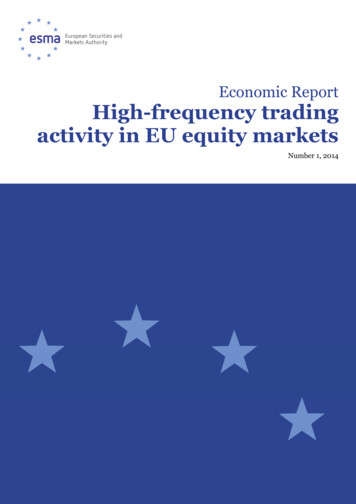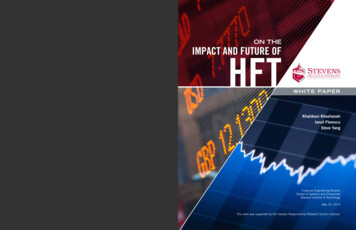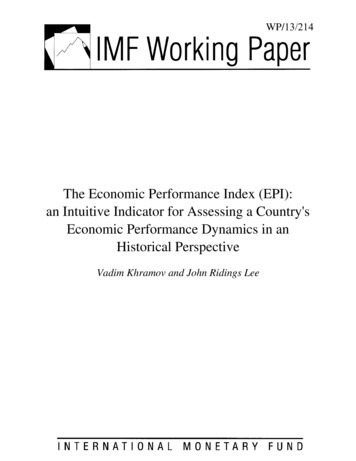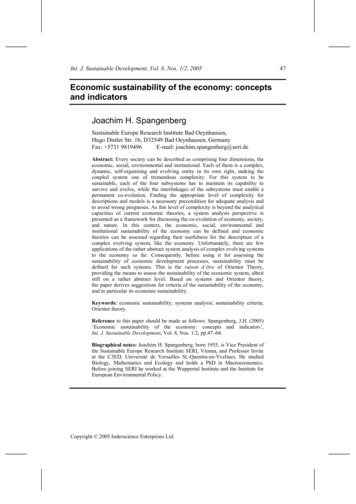
Transcription
Economic ReportHigh-frequency tradingactivity in EU equity marketsNumber 1, 2014
ESMA Economic ReportNumber 1, 20142ESMA Economic Report, Number 1, 2014Authors:Authorisation:Note:Antoine Bouveret, Cyrille Guillaumie, Carlos Aparicio Roqueiro, Christian Winkler, Steffen Nauhaus.This Report has been reviewed by ESMA’s Committee for Economic and Market Analysis (CEMA)and has been approved by the Authority’s Board of Supervisors.Under MiFID II ESMA is required to provide technical advice to the European Commission to furtherspecify the definition of HFT. This Economic Report provides an overview of HFT identificationmethods as well as indications about the extent of HFT activity across the EU and does not prejudicethe policy process and its outcomes. European Securities and Markets Authority, Paris, 2014. All rights reserved. Brief excerpts may be reproduced ortranslated provided the source is cited adequately. Legal reference of this Report: Regulation (EU) No 1095/2010 of theEuropean Parliament and of the Council of 24 November 2010 establishing a European Supervisory Authority(European Securities and Markets Authority), amending Decision No 716/2009/EC and repealing CommissionDecision 2009/77/EC, Article 32 “Assessment of market developments”, 1. “The Authority shall monitor and assessmarket developments in the area of its competence and, where necessary, inform the European Supervisory Authority(European Banking Authority), and the European Supervisory Authority (European Insurance and OccupationalPensions Authority), the ESRB and the European Parliament, the Council and the Commission about the relevantmicro-prudential trends, potential risks and vulnerabilities. The Authority shall include in its assessments an economicanalysis of the markets in which financial market participants operate, and an assessment of the impact of potentialmarket developments on such financial market participants.”European Securities and Markets Authority (ESMA)Economics and Financial Stability Unit103, Rue de GrenelleFR–75345 Paris Cedex 07financialstability@esma.europa.eu
ESMA Economic ReportNumber 1, 20143Table of ContentsExecutive summary 4Introduction 5Definition and identification of high-frequency trading activity 5Direct approach 6Indirect approach 6HFT identification methods used in this report 8Description of dataset 9Sample of stocks 9Data collection and timespan 10Market participants 10HFT activity on European equity markets 11Overall results for HFT activity 11Lifetime of orders approach – robustness of results regarding the time threshold 11Activity by different type of market participants 12Colocation 13Patterns in HFT activity 14HFT activity and underlying stocks’ features 15Conclusion 15Annex 1: Literature review 19Annex 2: Estimates of HFT activity for alternative HFT identification methods 24Annex 3: Stratified approach used to identify market participants 27Annex 4: Sampling procedure used for establishing the sample of stocks 28Annex 5: Presentation of the database 30
ESMA Economic ReportNumber 1, 20144Executive summaryThe objective of this report is to shed further light on the extent of high-frequency trading (HFT) in EU equity markets.We use unique data collected by ESMA, covering a sample of 100 stocks from nine EU countries for May 2013. Ourstudy complements the HFT literature by looking at equity markets across a number of EU countries. Most of the HFTstudies published so far focus either on the US or on a single country within Europe.One of the challenges faced by empirical studies is the operational definition of HFT. There is a variety of approaches inthe literature to estimate HFT activity. None of these approaches is able to exactly capture HFT activities and they leadto widely differing levels of HFT activity. This is an important issue for the analysis of HFT activity and its impacts. It isalso a significant challenge for regulators who need to define what constitutes HFT activity. The approach taken in thisreport is to provide a lower and an upper bound for HFT activity.Two main approaches have been used in the literature: i) a direct approach based on the identification of HFT firmsaccording to their primary business or the types of algorithms they use, and ii) an indirect approach based on statisticssuch as lifetime of orders or order-to-trade ratio.We provide estimations for HFT activity based on the primary business of firms (direct approach) and based on thelifetime of orders (indirect approach). The first proxy is an institution-based measure (each institution is either HFT ornot), while the second proxy is a stock-based measure (an institution may be HFT for one stock but not for anotherone).The results based on the primary business of firms provide a lower bound for HFT activity, as they do not capture HFTactivity by investment banks, whereas the results based on the lifetime of orders are likely to be an upper bound forHFT activity.In our sample, we observe that HFT activity accounts for 24% of value traded for the HFT flag approach and 43% forthe lifetime of orders approach. For the number of trades the corresponding numbers for HFT activity are 30% and49%, and for the number of orders 58% and 76%. The difference in the results is mainly explained by HFT activity ofinvestment banks which is captured under a lifetime of orders approach, but not under a HFT flag approach (see tableC.1).HFT activity – overall results for the HFT flag and lifetime of orders approachesC.1HFT flagLifetime of orderslifetime of orders: totalthereof HFT firmsthereof investmentbanksthereof other firmsValue traded244319222Number of trades304925232Number of orders587655191Note: Figures are weighted by value of trades (value traded), number of trades, and number of orders; in %.Source: ESMA.Our results also show that the level of HFT activity varies widely between trading venues. We also observe that HFTactivity is linked to market capitalisation with HFT activity increasing with the market capitalisation of stocks.This report describes the results of the first part of the ESMA research on HFT. Further research is needed regarding— the drivers of HFT activity,— to assess the actual contribution of HFT to liquidity, and— to analyse potential risks and benefits linked to HFT activity.
ESMA Economic ReportNumber 1, 20145High-frequency trading activity in the EUIntroductionOver the last few years, financial markets have undergone aseries of significant changes. Regulatory developments,technological innovation and growing competition haveincreased the opportunities to employ innovativeinfrastructures and trading practices. On the regulatoryside, the entry into force of the Market in FinancialInstruments Directive (MiFID) in 2007 has re-shapedmarkets in the EU. At the same time, developments intrading technologies enabled the use of automated andvery fast trading technologies. The resulting tradinglandscape can be characterised by higher competitionbetween trading venues, the fragmentation of trading inthe same financial instruments across venues in the EU aswell as the increased use of fast and automated tradingtechnologies.These developments have interacted with each other. Onthe one hand, increases in competition as well as in thedispersion of trading may have boosted the use ofalgorithmic trading. On the other hand, increasedcompetition could have been possible, at least partly,because of high-frequency trading (HFT) activity, as HFT isable to integrate activity on different venues.1At the same time, a series of events such as the May 2010Flash Crash in the US, problems faced during BATS andFacebook IPOs and the loss of USD 420mn by KnightCapital in August 2012 due to a malfunctioning algorithmhave called into question the benefits and risks linked toalgorithmic and high-frequency trading. In particular, theimpact of HFT on volatility, liquidity and, more generally,market quality has been an important topic for securitiesmarket regulators, academics and market practitioners.While the academic and policy-oriented literature hadoriginally focused predominantly on US markets, researchinto EU equity markets has been increasing in recent years.The focus typically is on a specific EU country and/ortrading venue.2The objective of this report is to shed further light on theextent of HFT on EU equity markets using unique datacollected by ESMA. In particular, this report discusses theidentification of HFT and provides estimates of HFTactivity based on a cross-EU sample of stocks.The structure of the paper is as follows. First, an overviewof different methods for identifying HFT activity isprovided. Second, we describe our dataset, after whichindications for the extent of HFT activity in EU equitymarkets are provided. The last section concludes.See Pagano (1989) for the general argument and Biais and Woolley(2011) for the application in the context of HFT.2 See Annex 1 for a survey of the literature on HFT identification. For asurvey of the HFT literature see also U.S. Securities and ExchangeCommission (2014). Specific examples for studies of European marketsare inter alia: Brogaard et al. (2014) for LSE, Gomber and Gsell (2009)and Hendershott and Riordan (2013) for Xetra, Hagströmer and Nordén(2013) for Nasdaq-OMX, Jovanovic and Menkveld (2010) for NYSEEuronext Amsterdam and Chi-X.1Definition and identification of highfrequency trading activityAlgorithmic trading (AT) and high-frequency trading(HFT) are trading practices which are still relatively recentand which are still evolving. A precise definition is thusemerging only slowly. A legal definition is provided byMiFID II.3 In a research context, the academic literature isnarrowing down its definition to a few identifying features.In general, total trading activity can be divided intoalgorithmic trading (AT) and non-algorithmic trading,depending on whether or not market participants usealgorithms to make trading decisions without humanintervention. Kirilenko and Lo (2013), for example,describe AT as “the use of mathematical models,computers, and telecommunications networks to automatethe buying and selling of financial securities”.Brogaard (2012) describes high frequency traders, in turn,as “the subset of algorithmic traders that most rapidly turnover their stock positions.” Following definitions proposedin the literature, HFT has the following features— proprietary trading;— very short holding periods;— submission of a large number of orders that arecancelled shortly after submission;— neutral positions at the end of a trading day; and— use of colocation and proximity services to minimiselatency.4From an analytical perspective, the absence of a uniquedefinition makes it difficult to achieve a preciseidentification of HFT activity. The literature employs anumber of approaches to identify HFT activity. These useone or several of the aforementioned characteristics andlead to differing results in assessing the level of HFTactivity in equity XT/PDF/?uri CELEX:32014L0065&from ENArticle 4(1)(39) of MiFID II states that algorithmic trading “means tradingin financial instruments where a computer algorithm automaticallydetermines individual parameters of orders such as whether to initiate theorder, the timing, price or quantity of the order or how to manage theorder after its submission, with limited or no human intervention, anddoes not include any system that is only used for the purpose of routingorders to one or more trading venues or for the processing of ordersinvolving no determination of any trading parameters or for theconfirmation of orders or the post-trade processing of executedtransactions”.3Article 4(1)(40) of MiFID II describes a high-frequency trading techniqueas “an algorithmic trading technique characterised by: (a) infrastructureintended to minimise network and other types of latencies, including atleast one of the following facilities for algorithmic order entry: co-location,proximity hosting or high-speed direct electronic access; (b) systemdetermination of order initiation, generation, routing or executionwithout human intervention for individual trades or orders; and (c) highmessage intraday rates which constitute orders, quotes or cancellations”.4 See U.S. Securities and Exchange Commission (2010).
ESMA Economic ReportNumber 1, 20146In the following we describe different approaches used inthe literature. These fall into two broad categories – directand indirect approaches.flags for proprietary and agent trading may not to be fullyconsistent across venues, making a cross-country andcross-venue comparison difficult.We focus on methodological advantages and disadvantagesboth in a general context and in the context of our dataset.Indirect approachThe second direct method to identify HFT activity relies onprior information on the use of low-latency infrastructure e.g. the use of colocation and proximity services or accessto fast data feeds. This approach does not require anyknowledge of the firm’s primary business, but can be tooencompassing as brokers trading exclusively on behalf oftheir clients (agent trading) may also use colocationservices to offer best execution strategies to their clients.Therefore, relying only on colocation would inflatestatistics on HFT activity. This is corroborated by ouranalysis.One possibility to deal with the overestimation issue wouldbe to focus on proprietary trading by participants usingcolocation services. However, this is difficult in practice, as5 Brogaard et al. (2013b) used an additional list based on the identificationof type of participants by trading venues and based on supervisoryknowledge.Using trade data, Jovanovic and Menkveld (2012) andKirilenko et al. (2010) define HFT firms as intermediarieswith high volumes traded and low intraday and overnightinventories, in line with the main characteristics of HFT.Chart C.2 shows an illustrative example based on mock-updata. Member 2 is a net seller of the stock, whileMembers 1 and 3 manage their inventories so to have a flatposition at the end of the day. However, Member 3manages its inventory intraday in order to have a flatposition also during the trading day, while Member 1 has anet seller position throughout most of the trading day. Inthis example, Member 3 would be flagged as HFT.Intraday inventory management15,000C.204: 52.51500010,000100005,000500000-5,000-5000Member 1Member 11:14-1000010:59-10,00010:48Consequently, relying on the primary business of firms hasan element of underestimation (HFT activity by other nonHFT firms not counted) as well as an element ofoverestimation (not all activity by HFT firms is in factHFT). Firms with HFT as primary business will in alllikelihood predominantly use HFT strategies. Therefore itis likely that the underestimation element is dominating.This is corroborated by the analysis carried out with ourdata set. The HFT flag approach provides the lowestestimates for HFT activity. Additionally, under the lifetimeof orders approach, most of the trading activity carried outby HFT firms is identified as HFT activity. Therefore, weconsider the HFT flag approach to provide for a lowerbound in terms of estimation of HFT activity.1) Intraday inventory management10:30The former method is used by Brogaard et al. (2013a) andBrogaard et al. (2013b). Information on the primarybusiness of firms is either obtained by the trading venueand/or by the authors of the study.5 This approach focuseson pure HFT firms which are flagged as HFT firms. It doesnot cover HFT activity by other firms, such as HFT activitycarried out by investment banks. It may not include activityby HFT firms routing their trading activity through anothertrading venue member (direct market access or sponsoredaccess), unless the broker reports the HFT firms as clients.The HFT flag approach also implies that all trading by theidentified firms is considered HFT, while in practice theymay use HFT and non-HFT strategies.10:21their primary business and / orthe use of services to minimise latency.09:49-09:27The direct approach to identify HFT activity relies on theidentification of market participants either based onIndirect approaches rely on the trading and quotingpatterns of market participants. Identification based oninventory management, for example, is closely related tothe broader concept of trading patterns. Examples relatedto quoting patterns are identification based on the lifetimeof orders, message traffic, order-to-trade ratios and HFTfirm strategies.09:04Direct approachMember 3Note: Net inventory of firms, based on mock-up data.Source:ESMA.Identification based on intraday inventory managementwill tend to identify high-frequency market makingstrategies and may not identify other strategies.In addition, to have a complete picture of intradayinventory management of firms, data on equity are likely tobe insufficient as positions in related financial instrumentssuch as equity swaps, ETFs or equity futures will not beconsidered.2) Lifetime of ordersAn alternative approach consists in looking at the lifetimeof orders, i.e. the time elapsed before the order is modifiedor cancelled. Chart C.3 is based on our dataset. It shows thelifetime of orders for HFT firms, investment banks andother firms. Firms identified as HFT under the directapproach appear to send orders with shorter lifetime (40%less than 0.2 seconds), compared to Investment banks(40% less than 5 seconds) and other firms (40% less than 3seconds).
ESMA Economic ReportDistribution of lifetime of ordersNumber 1, 2014C.37Order lifetime thresholds to identify HFT activity can beset in a number of ways and have both absolute andrelative dimensions.One possibility is to set thresholds both in an absolutedimension (x milliseconds) and in a relative dimension (y%of orders need to be modified in less than x milliseconds).The absolute dimension captures the speed of tradingactivity; the relative dimension takes into account thatsome firms might use ‘slow’ orders alongside HFT activity(e.g. investment banks for agent orders). This type ofapproach is well suited to datasets which identify HFTactivity at a certain point in time, but does not take intoaccount that trading speed changes over time throughtechnological progress.However, some firms, not flagged as HFT under the directapproach, may also be able to send very quick orders. ChartC.4 indicates that the 25% quickest investment banks andthe 25% quickest other firms (first quartile) were able tomodify or cancel their orders faster than the median ofHFT firms.Distribution of lifetime of ordersC.4An alternative is using purely relative thresholds. Hereactivity would be classified as HFT when the lifetime oforders of a firm is lower than e.g. the median of the lifetimeof all orders on a trading venue. This threshold can be setat the level of an individual stock or for all trading activityof a firm on a trading venue. Setting purely relativethresholds takes account of changes in the speed of overalltrading activity, however, the relative threshold needs to becalibrated carefully.For both the absolute and the relative approach,there is norule which threshold would characterise HFT activity in aprecise manner. Therefore thresholds need to be calibratedcarefully and robustness checks should be carried out.Hasbrouck and Saar introduce two identificationapproaches related to the lifetime of orders. The concept of“fleeting orders” originates from Hasbrouck and Saar(2009) and is defined as an order that is added andremoved from the order book within a given short period oftime (x milliseconds). Hasbrouck and Saar (2013)introduce the concept of strategic runs, which they defineas a sequence of linked order book messages. Moreprecisely, strategic runs are defined as a series of at least cutively in less than one second over a 10-minuteinterval. The classification of HFT activity according to thelifetime of orders is based on the ability of a marketparticipant to very quickly modify or cancel orders and canbe computed for individual stocks rather than at firm level.Firms may have HFT activity in some stocks, but not inothers. The lifetime approach can identify trading activityin stocks where firms act as HFT.To operationalise this approach several dimensions need tobe considered. Firstly, order lifetime thresholds to classifytrading activity as HFT or non-HFT need to be set.Secondly, the level of granularity for the analysis regardingthe trading activity of firms needs to be defined.For both approaches, there is a potential to both underand overestimate HFT activity. Trading activity of a groupis either classified as HFT or not. HFT activity might beunderestimated if only a small portion of a group’s tradingactivity involves very quick order cancellations andmodifications. On the other hand, there is also a distinctpossibility of overestimating HFT activity. This wouldparticularly be the case for investment banks, who arecaptured as HFT based on their overall trading patterns,although HFT is likely to constitute only part of their totaltrading activity. Hence, these approaches could captureboth the activity of an HFT desk and the slower agentbased trading activity. On balance, it is likely that thelifetime of orders approach at a group level overestimatesHFT activityOur dataset provides a snapshot of trading activity over ashort time period. We therefore use absolute thresholds forour headline results6. Regarding the aforementionedoverestimation issues, there are two ways to mitigate these.Firstly, a flag in the data for proprietary and agent orderscould be used as a proxy. While our dataset has such a flag,the quality of the data is insufficient to use it.Secondly, the lifetime of orders can also be calculated atthe firm or participant level, instead of at group level. Thiswould mean that only the activity by “fast” participantswithin a group would be captured as HFT activity, whereas6 For reference we also describe how much trading activity would beclassified as HFT activity under a purely relative threshold in Annex 2.
ESMA Economic ReportNumber 1, 2014the activity of the “slower” firms within the group wouldnot. This approach is feasible in our dataset. However, dataissues were encountered, leading to biases in the results(see Annex 2 for the results and a description of the dataissues). Therefore, we calculate the lifetime of orders atgroup level.3) Message traffic (including order-to-trade ratios)Proxies based on message traffic have been used to identifyAT and HFT by academics, industry bodies, trading venuesand regulators. Hendershott et al. (2011) use the number ofmessages per 100 of trading volumes along with messageto-trade ratios. The German HFT Act, which came intoforce on 15 May 2013, uses message traffic as one of theelements to identify HFT firms. Firms generating messagetraffic of more than two messages per second or 75,000messages per trading day are considered to be HFT firms ifthey also fulfil the other criteria of the HFT act. Theserelate to the use of infrastructure intended to minimiselatency and system determination of individual orders andtrades, i.e. orders are initiated, generated, routed orexecuted without human intervention.In North America, a report on HFT published by theInvestment Industry Regulatory Organization of Canada(2012) uses order-to-trade ratios (OTR) as a proxy forHFT. High order-to-trade ratio (“HOT”) traders wereidentified as the ones with the largest ratios compared tothe entire sample.7 The Australian Securities &Investments Commission (2013) uses a mix of indicators toidentify HFT in Australia, one of them being OTR.However, using only OTR may lead to biases in the results.Firstly, this approach identifies mostly passive HFTstrategies, such as market making where participantsregularly update their bid and ask quotes, resulting in highOTR.8 Statistical arbitrage strategies, which rely on lowlatency, would not be captured by this metric as they donot require high OTR. Secondly, algorithms used by firmsfor agency trading on behalf of institutional investors mayresult in high OTR and therefore be mislabelled HFT, asnoted by Malinova, Park and Riordan (2013). Thirdly,some firms may only have executed few trades (or none atall) despite having sent orders, resulting in very high OTR.This might be particularly the case for less liquid stocks,which could result in higher OTR for them, implying thatHFT activity is higher for less liquid stocks than for bluechips, which is not in line with existing empirical evidence.Finally, the OTR measure does not take into account thespeed at which orders are sent. Hence a firm using analgorithm that updates orders every 10 minutes could havea high OTR even though it is not implementing any HFTstrategy.7 More precisely, orders were first de-trended and HOT were defined astraders at the right tail of the distribution, using a 1.25 standard deviationcut-off point, resulting in an order-to-trade ratio of 11.2 for the HOTgroup (See Investment Industry Regulatory Organization of Canada,2012).8 See Brogaard et al. (2014).8In other words, OTR is rather a measure of message trafficthan a measure of HFT. It is a useful metric to assesspotential risks linked to trading system overload ratherthan a method to identify firms carrying out HFT activity.Looking at our data confirms these considerations. HFTfirms exhibit significant heterogeneity. The medianunweighted order-to-trade ratio is around 18, while thefirst quartile is around 3 and the third quartile close to 64.This indicates that HFTs are not a homogeneous category,probably due to the different strategies implemented. Forinvestment banks and other traders, however, order-totrade ratios centre more around the median, as illustratedin C.5.Dispersion of order-to-trade ratiosC.5120100806040200HFTQ3IBQ1OthersNote: Distribution of order-to-trade ratios by traders by quartile and 10% and 90% percentiles .Source: ESMA.4) Identification of strategiesMore recently, a few papers have looked at the strategiesimplemented by HFT firms. Using data from NASDAQOMX, Hagströmer and Nordén (2013) are able to identifymarket making HFT and opportunistic HFT (arbitrage andmomentum strategies).This type of approach is useful to identify the extent towhich certain HFT business models contribute to marketactivity, but may be less suited to identify the overall levelof HFT activity in equity markets.HFT identification methods used in this reportAs discussed above, a precise identification of HFT activityis difficult to achieve; from an analytical perspective nosingle method will exactly capture the extent of HFTactivity.Therefore we will present estimates based on a direct HFTidentification approach, using a HFT flag, and an indirectidentification approach, based on the lifetime of orders.For the HFT flag approach a list of firms that engage inHFT has been established with reference to the marketparticipants’ primary business based on the informationavailable on their websites, on business newspaper articlesand on industry events. In certain cases the flagging offirms was also discussed with supervisors. 20 groups (outof a total of 394) were classified as HFTs in this way.
ESMA Economic ReportNumber 1, 2014Our identification rule for HFT activity according to thelifetime of orders approach is as follows: if the 10%quickest order modifications and cancellations of a givenfirm in any particular stock are faster than 100ms, then thetrading activity of the firm in that particular stock isconsidered HFT activity.There is no rule which threshold would characterise HFTactivity in a precise manner. We have therefore carried outrobustness checks and will provide an overview of levels ofHFT activity under a lifetime of orders approach for arange of time thresholds.Thus, our approach is to present a range of estimates forHFT activity based on a HFT flag approach and an orderlifetime approach. The results based on the HFT flagprovide a lower bound for HFT activity, as they do notcapture HFT activity by investment banks. The resultsbased on the lifetime of orders are likely to be an upperbound for HFT activity. As noted above, there may be somedegree of overestimation of HFT activity under thisapproach.Description of datasetSample of stocksA sample of 100 stocks traded in Belgium (BE), Germany(DE), Spain (ES), France (FR), Ireland (IE), Italy (IT), theNetherlands (NL), Portugal (PT) and the United Kingdom(UK) has been chosen. A stratified sampling approach hasbeen used. For each country, stocks have been split byquartiles according to their market value, value traded andfragmentation using September 2012 data9. As in Degryseet al. (2011), fragmentation (, of stock is on day ) isdefined as:,w
The objective of this report is to shed further light on the extent of high-frequency trading (HFT) in EU equity markets. We use unique data collected by ESMA, covering a










